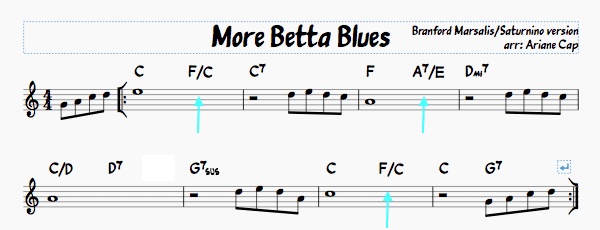After taking a look at the first inversion of a triad (sampled with Deep Blue Something’s Breakfast at Tiffany), let’s check out the second inversion.
If you missed the basics, here they are:
What’s the second inversion of a triad?

Play it on your bass to hear it
G/D? Say “G over D”: A G-major triad over a low D note.
What do Second Inversions sound like?
A second inversion chord sounds even less stable than the first inversion! This configuration features the interval of the fourth between the lowest note (the fifth of the triad) and the next note (the root). There is no third in this chord as seen from the lowest note!
In the above example, you find the fourth between the D and G. Sure, the first inversion contains a fourth as well, but it does not form a fourth with the bass note and the first inversion does have a third as seen from the lowest note. Thirds with the root always lend stability to the sound, whereas fourths sound like they want to resolve to the nearest third or they have a rub (like in a sus chord).
So, second inversions combine the sound of a triad (because we are inverting one) with the sus4 sound (because the lowest note of the chord forms a fourth with the next note higher).
Second inversions are typically not used as standalone chords, but they do show up frequently as part of very well known progressions. We can pick out three common uses:
- as part of a descending stepwise bass line;
- over a pedal;
- in a “cadence” – a type of turn around, if you will;
1. Second Inversions as Part of a Descending Stepwise Bass Line
Here the second inversion shows up as a passing chord with the bass moving stepwise, most often the direction we are going in is descending:
For example:
C – E/B – Amin creates a “V-I movement” (C to E to Amin, where E is the V chord to Amin; also called a secondary dominant – a topic for another post)
This also sounds great in minor:
|| Cmin | Eb(7)/Bb | Ab (here the V – I movement is from Eb7 to Ab)
Another example is this more ”classical” sounding variation on a Gospel ending
| C ||: F | C/E | G/D | C :|| (C/E of course being a first inversion, G/D being the second)
2. Second Inversion Over a Pedal: Van Halen’s Jump! & Mercy Mercy (Joe Zawinul)
Here is the riff from Van Halen’s song Jump! blue arrow = second inversion
Check out the C pedal in the bass with the chords moving over it. In the recording the bass is playing pumping eighth notes of that C:
You’ll find a similar configuration in the bridge of Mercy Mercy:
|| C | F/C | C7 | F/C ||

2. Second Inversion as a Cadence (a Type of Turn Around, if you will)
Most often used as a so-called “cadential 6/4” – 6/4 is just another name for the second inversion (called so because of the two intervals from the bass note are a fourth and a sixth). And cadential because it is a variation of a V-I such as:
| C/G | G7 | C ||.
In context, for example, featuring the walk down second inversion as well:
||C | E/B | Amin | C7/G | F | D7/F# | C/G | G | C ||
This cool tune by Branford Marsalis showcases several of the above second inversions:
“Mo Better Blues” is originally in Gb. The tune has an eight-bar Blues-like form which basically is a I-IV-ii-V progression that is nicely enhanced with several harmonic devices.
Transposed to C, notice the second inversions in bars 1, 3 and 7.
- First bar: check the second inversion over a pedal bass (the same happens in the bridge of Zawinul’s “Mercy Mercy Mercy” by the way, see above)
- Third bar: featuring the second inversion over a descending passing note in the bass
- And check out bar 7: here we have a second inversion over a pedal bass whereas the chord after it returns to the starting chord. When you hear a chordal instrument (piano or guitar for example) do this at the end of a form, most often the bass stays on the root, meaning it doesn’t go to the IV chord and then back.
Compare the simple version of the chords (without inversions, walk downs etc), to the one with inversions:
basic chords:
|| C F | C | F | Dmi | Dmi7 | Gsus7 | C F | C ||
chords with inversions and more:
|| C F/C | C7 | F A7/E | Dmi | C/D D7 | Gsus7 | C F/C | C ||
Here is a lead sheet of the song:







